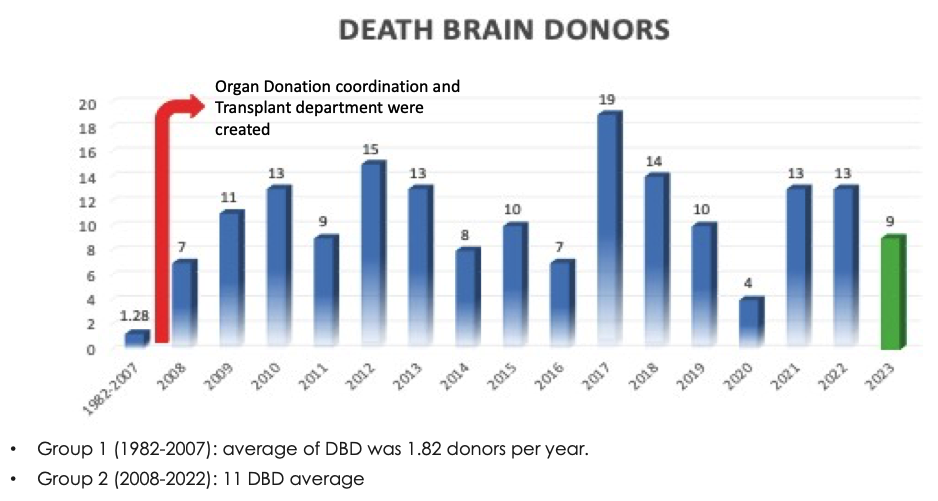Is it possible to become a leader hospital in organ donation in a short time?
Martha Pérez Cornejo1,3,6, Ernesto Duarte Tagles2,4,5, Alejandro R Bernal Yanes6, María F Félix Rodríguez7, Daniel Rosas Salazar7, Natalia Rodríguez Payán2, Luis C Rodríguez Sancho2.
1Organ office coordination, Hospital CIMA Hermosillo, Hermosillo, , Mexico; 2Transplant department, Hospital CIMA Hermosillo, Hermosillo, , Mexico; 3Intensive care unit, Hospital San José de Hermosillo, Hermosillo, , Mexico; 4Surgery department, Hospital San José de Hermosillo, Hermosillo, , Mexico; 5Transplant department, Hospital General del Estado del Estado de Sonora, Hermosillo, , Mexico; 6Organ office coordination and Intensive care unit, Hospital General del Estado del Estado de Sonora, Hermosillo, , Mexico; 7School of Medicine, Universidad de Sonora, Hermosillo, , Mexico
Introduction: When organ donation from Brain Death Donor (DBD) started, the hope of a cure for these patients increased but as time went by, become a reality that obtain organ from a death donor was difficult. In Mexico, although first transplant was done in 1963, there has been a little impact in organ donation from a DBD. In 1983, Mexican General Health Law stablished all the principles under all organ donation and transplantation should run, and by year 2000, Centro Nacional de Trasplantes (CENATRA) was created, in order to lead efforts nationwide to increase organ donation rate. Mexico legislation established every state must have a state transplant office and every hospital should have a special license that allows it to do organ procurement; in order to have this license, it is mandatory to have an Organ Donation Coordinator, who has a special training given by CENATRA and Universidad Nacional Autónoma de México. This coordinator must do all the work directed to get as much as donations are possible. In this study, we want to show how a hospital, with intensive care unit people working specifically in organ donation, with focus trainee and a program aim to get organ donation can make increase organ donation and thus become a nationwide leader in the field.
Methods: we collected all data information about organ donation since 1982, when first kidney transplant was done in our hospital. We separate data from 1982-2007 and 2008-2023, when transplant department and organ donation coordination were created. We obtain data on number of DBD, as well as general data of donors such age, gender, blood type and organs obtained during these years.
Results: from 1982 to 2007 the average of DBD in our hospital was 1.82 donors per year. In 2008, when a transplant department and organ donation coordination were created, number of donors raised up to 7 donors and constantly did for the next years. In 2012, appeared by the first time ranked in the top 5 hospital with most DBD in whole country and over the last 10 years, the hospital has appeared 7 times in this list, being 2nd place three times in 5 years. In 2021, death donor rate was 17.2 pmp. Since 2008, we have had 170 DBD, median age 39.5 years, 68 % were male and 32% female.


Conclusion: We think demonstrate it is possible to increase number of donations relatively fast and keep high frequency. Our proposal to have these results are:
1) Organ donation coordinator to be and Intensive Care physician or related, so detection and maintenance of a DBD would be much easier.
2) To have a transplant department and not just different specialties getting together to perform a transplant, in this way, the head of department work together with organ donation coordination to create awareness of the importance of the program inside the hospital but also to the community.
3) Communicate, have transparency and always willing to inform, in order to create confidence among people.
